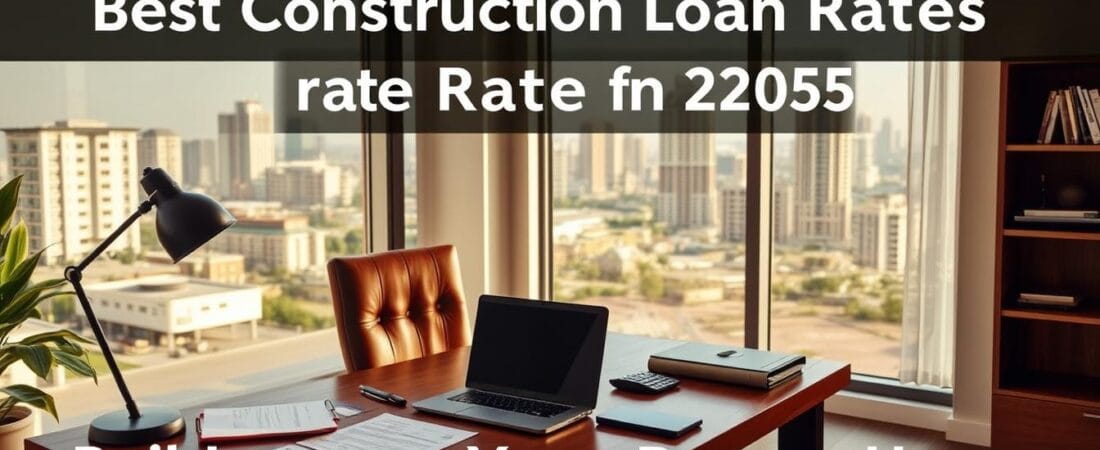Did you know that over 60% of homeowners who build custom homes rely on specialized financing options? With the right strategy, you can save thousands during the process. The year 2025 brings a competitive landscape for financing, making it an ideal time to plan your dream project.
Understanding the nuances of financing is crucial. From rate lock strategies to permanent loan conversions, every step impacts your long-term savings. Whether you’re planning a standard build or a unique project like a barndominium, flexible options are available to suit your needs.
For those tackling larger projects, jumbo loans provide solutions for amounts exceeding $726,200. Institutions like SCCU and USU Credit Union are leading the way with competitive offerings. To learn more about managing your finances effectively, check out our guide on low-fee robo advisors for 2025.
Key Takeaways
- 2025 offers competitive financing options for building projects.
- Rate lock strategies can lead to significant long-term savings.
- Understanding permanent loan conversion is essential post-construction.
- Jumbo loans are available for projects over $726,200.
- Flexible financing includes options for ADUs and barndominiums.
What Are Construction Loans and How Do They Work?
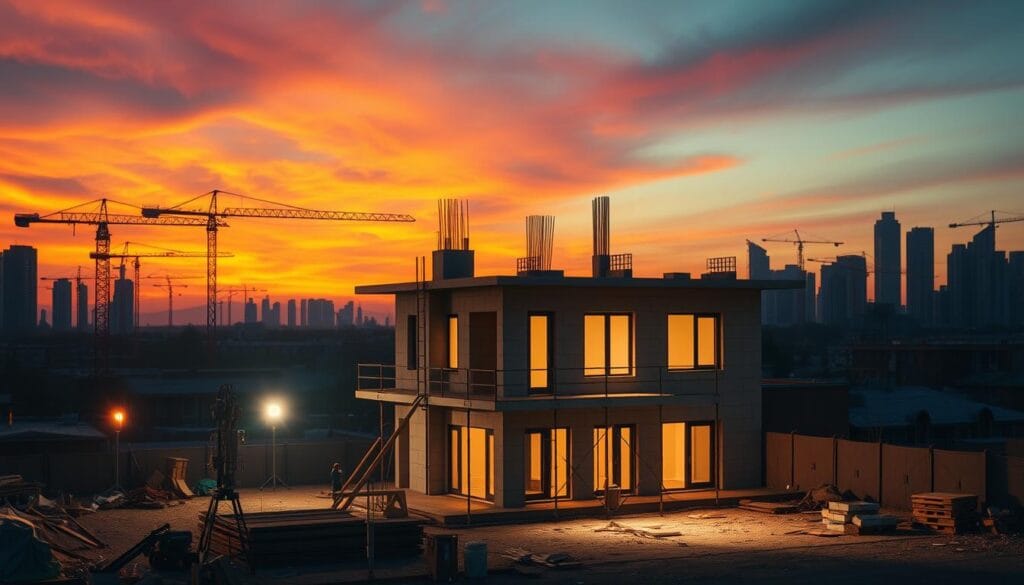
Building a custom home requires a unique financing approach. Unlike traditional mortgages, specialized options are designed to fund the entire process, from breaking ground to moving in. These financial tools are tailored to meet the specific needs of custom builds, ensuring flexibility and efficiency.
Understanding the Basics of Construction Loans
These financial solutions are structured to cover the costs of building a home. Funds are typically disbursed in stages, known as draw schedules, based on the progress of the project. This ensures that builders are paid as milestones are met, reducing financial risks for both parties.
Interest-only payments are common during the construction phase, calculated on the amount disbursed. This approach keeps initial costs manageable while the project is underway. Once construction is complete, the financing can either be paid off or converted into a permanent mortgage.
Construction-to-Permanent Loans Explained
One popular option is the construction-to-permanent hybrid. This combines the financing for building and the long-term mortgage into a single process. Institutions like SCCU offer a 12-month construction period with automatic conversion to permanent financing, simplifying the transition.
USU, on the other hand, provides weekly unlimited draws with a 48-hour turnaround, ensuring funds are available when needed. Their dual closing options—one-time or two-time—allow borrowers to choose the structure that best fits their needs. SCCU also includes a $1,400 upfront fee covering inspections and disbursements, adding transparency to the process.
Delays in construction can impact rate lock expiration and payment adjustments. It’s crucial to plan for potential setbacks to avoid unexpected costs. For more insights into managing finances effectively, explore our guide on decentralized lending benefits.
Why 2025 is the Perfect Time to Secure a Construction Loan

The year 2025 presents a unique opportunity for those planning to build their dream homes. With favorable economic conditions and competitive financing options, it’s an ideal time to start your project. Understanding the current market trends can help you make informed decisions and maximize your savings.
Current Market Trends in Construction Financing
Federal Reserve projections indicate stable interest rates for 2025, making it a favorable environment for long-term projects. Institutions like USU and SCCU are offering innovative solutions, such as USU’s float-down option, which allows rate adjustments post-occupancy certificate. This flexibility ensures borrowers can adapt to changing market conditions.
SCCU’s rate reset policy is another advantage, especially for extended timelines. If construction takes longer than expected, borrowers can reset their rates without penalties. These features provide peace of mind and financial security during the building process.
Benefits of Locking in Rates Early
Securing a favorable term early can protect you from potential market fluctuations. USU’s 7/1 ARM options offer flexibility during the permanent phase, allowing borrowers to adjust their payments as needed. Early rate locks also shield you from rising material costs, which are influenced by inflation.
Planning ahead ensures you can take full advantage of 2025’s predicted economic stability. Whether you’re building a custom home or a unique structure, locking in rates now can lead to significant long-term savings.
Top Construction Loan Rates for 2025
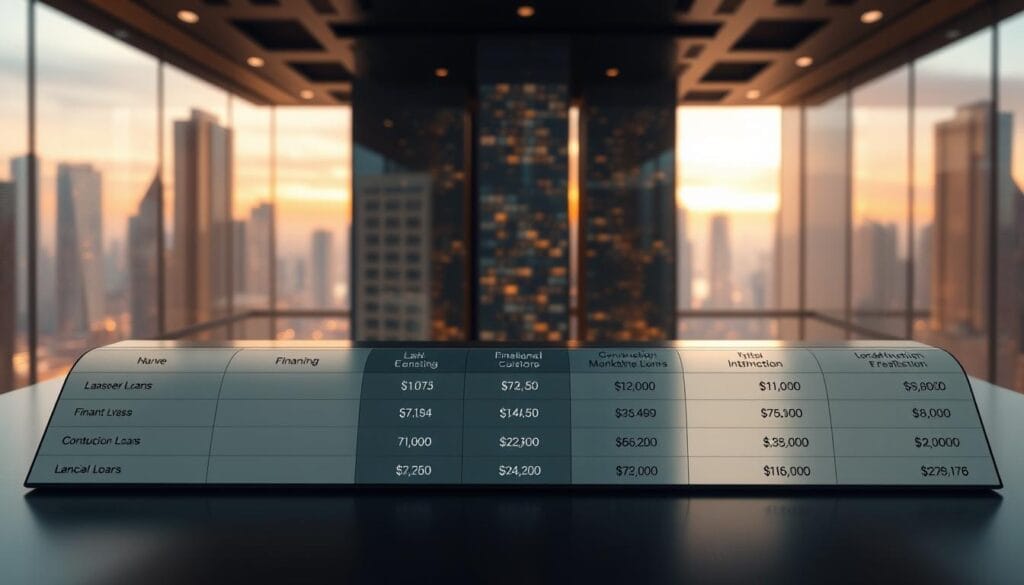
Finding the best financing options for your project starts with understanding the market. The year 2025 brings competitive offerings from leading institutions, making it easier to secure favorable terms. Whether you’re building a traditional home or a unique structure, comparing options is essential.
Comparing Interest Rates from Leading Lenders
USU and SCCU are two prominent names in the financing landscape. USU offers a 1% origination fee for one-time close options, while SCCU bases its terms on creditworthiness. These differences highlight the importance of evaluating multiple providers.
For example, USU’s 0.50% origination fee is lower than the industry average, making it an attractive choice. SCCU’s approach, which considers credit scores and financial history, ensures tailored solutions for borrowers.
Factors That Influence Financing Terms
Several variables impact the terms you’ll receive. Loan-to-value (LTV) ratios, for instance, can go up to 90% for contractor builds. This means borrowers with larger projects may need to provide a smaller down payment.
Project type also plays a role. ADUs and barndominiums often have different terms compared to traditional homes. Regional variations and local underwriting practices can further influence the final offer.
Lenders use risk assessment models to evaluate custom projects. These models consider factors like the borrower’s credit history and the complexity of the build. Understanding these criteria can help you prepare a stronger application.
For more details on managing your finances, visit our Terms and Conditions page.
How to Qualify for the Best Construction Loan Rates

Securing the best terms for your project starts with meeting specific criteria. Lenders evaluate multiple factors, including your credit score, financial health, and the documentation you provide. Understanding these requirements can help you prepare a strong application.
Credit Score and Financial Health Requirements
Your credit score plays a significant role in determining eligibility. Most lenders require a minimum score between 680 and 720. A higher score can lead to better terms and lower costs. Additionally, lenders assess your debt-to-income ratio to ensure you can manage payments during the building phase.
For owner-builder projects, institutions like USU cap financing at 85%. This means you’ll need to cover the remaining 15% of costs. SCCU also requires inspection contingencies, ensuring the project meets safety and quality standards before disbursing funds.
Documentation Needed for Loan Approval
Preparing the right paperwork is essential for a smooth approval process. Lenders typically require contractor bids, detailed building plans, and land deeds. These documents help assess the project’s feasibility and cost.
USU also verifies owner-builder experience, ensuring you have the skills to manage the project. SCCU emphasizes the importance of construction contingency reserves, which protect against unexpected expenses. Having these documents ready can speed up the approval process.
Construction Loan Rates 2025: What to Expect

Understanding the financial landscape for building projects in 2025 is essential for making informed decisions. With interest rates projected to remain stable, borrowers can plan their projects with confidence. Institutions like USU and SCCU are offering innovative solutions to meet diverse needs.
Predictions for Interest Rate Trends
Federal Reserve projections indicate that the Federal Funds Rate will remain steady in Q3 2025. This stability is expected to positively impact financing options for building projects. Borrowers can take advantage of this predictability to lock in favorable terms early.
USU’s 5/1 ARM options provide flexibility during the permanent phase, allowing adjustments based on market conditions. SCCU’s rate lock expiration policies ensure borrowers are protected from unexpected changes. These features make 2025 an ideal time to secure financing for your project.
How to Secure Low-Interest Financing
Leveraging builder relationships can help reduce costs. Builders often have partnerships with lenders, which can lead to better rate offers. Additionally, fixed-rate products are gaining popularity due to their predictability in a stable market.
Energy Star certifications can also lead to rate discounts. Lenders view energy-efficient projects as lower risk, offering incentives to borrowers. Regional competition in high-growth markets further drives down costs, making it easier to secure low-interest financing.
For more insights on managing your finances effectively, explore our guide on how to maximize savings with round-up apps.
Choosing the Right Lender for Your Construction Loan

Selecting the right lender is a critical step in ensuring a smooth financing process. With various options available, understanding the differences between credit unions and traditional banks can help you make an informed decision. Each type of lender offers unique benefits, so evaluating your needs is essential.
Top Lenders Offering Competitive Solutions
USU and SCCU are two prominent names in the financing landscape. USU provides direct lender access at 801-786-8400, while SCCU offers a streamlined online application portal. These features make the application process more convenient for borrowers.
Credit unions often provide personalized service and lower fees compared to traditional banks. However, banks may offer more extensive resources for larger projects. Evaluating both options ensures you find the best fit for your needs.
Questions to Ask Potential Lenders
When comparing lenders, ask about draw schedules and inspection protocols. These details can impact the timeline and efficiency of your project. Additionally, inquire about their experience in handling similar projects to ensure they have the necessary expertise.
Hidden costs, such as rate lock extensions or document processing fees, can add up. Clarify these upfront to avoid surprises. USU’s online rate quote system is a valuable tool for comparing offers, while SCCU’s transparent fee structure provides peace of mind.
Understanding the Construction Loan Process

Navigating the steps of financing a custom build can seem daunting, but breaking it down simplifies the journey. From the initial application to the final closing, each step plays a critical role in ensuring a smooth experience. Understanding these stages helps you stay prepared and avoid unexpected hurdles.
From Application to Closing: A Step-by-Step Guide
The process begins with the application, which typically takes 30-45 days for approval. During this time, lenders evaluate your financial health, credit score, and project details. Once approved, the first draw is scheduled, marking the start of the building phase.
Title companies play a vital role in multiple-draw scenarios, ensuring funds are disbursed securely. Change order management and modifications to the financing terms may arise as the project progresses. Staying organized and communicating with your lender is key to avoiding delays.
What Happens During the Construction Phase?
This phase involves critical milestones, such as inspections and disbursements. SCCU, for example, operates within a 12-month timeline, while USU guarantees 48-hour draw processing. These timelines ensure funds are available when needed, keeping the project on track.
Post-occupancy conversion deadlines are another important aspect. Once the build is complete, the financing transitions to a permanent mortgage. Proper documentation and adherence to deadlines are essential for a seamless closing.
One-Time Close vs. Two-Time Close Construction Loans
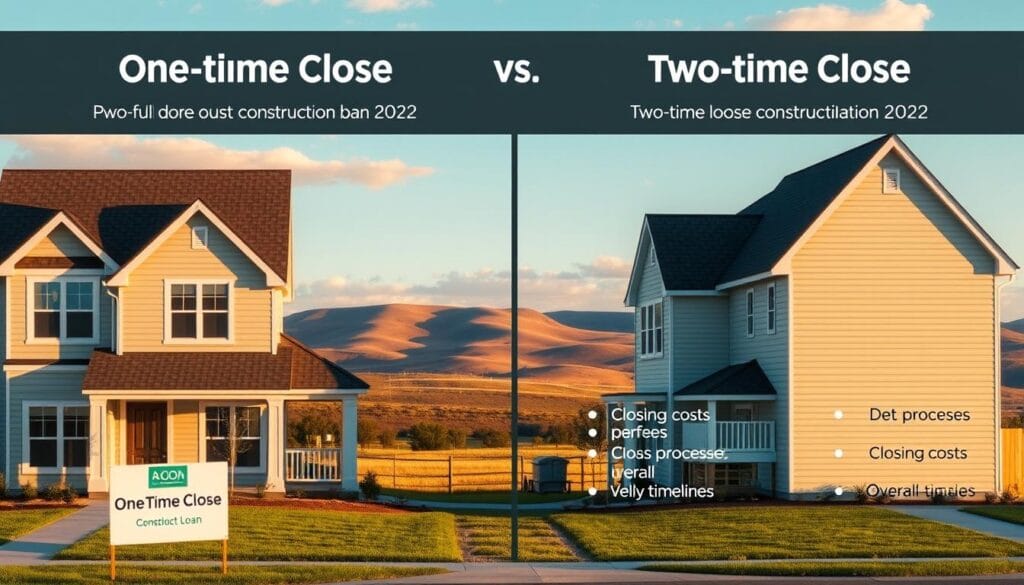
When planning your custom build, understanding the differences between financing options is crucial. One-time and two-time close structures each have unique benefits and drawbacks. Choosing the right one depends on your project’s needs and financial goals.
Pros and Cons of Each Option
One-time close financing simplifies the process by combining the construction and permanent phases into a single closing. This approach often features a fixed term, providing stability throughout the project. However, it may come with higher upfront costs, such as a 1% origination fee.
Two-time close financing, on the other hand, involves separate closing processes for each phase. While this can offer lower initial costs, it exposes borrowers to potential interest rate fluctuations during the construction phase. Additionally, there’s a risk of not qualifying for the second loan.
Which One is Right for You?
For those prioritizing simplicity and predictability, one-time close financing is often the better choice. It eliminates the need for a second approval process and provides a fixed rate for the entire term. This is particularly beneficial for custom home builds where timelines may vary.
Two-time close financing may suit borrowers who are confident in their ability to secure a second loan and want to minimize upfront expenses. It’s also a viable option for spec home projects, where the construction phase is shorter and more predictable.
For more insights into managing your finances effectively, explore our guide on micro-investing platforms.
Construction Loan Fees and Costs to Consider
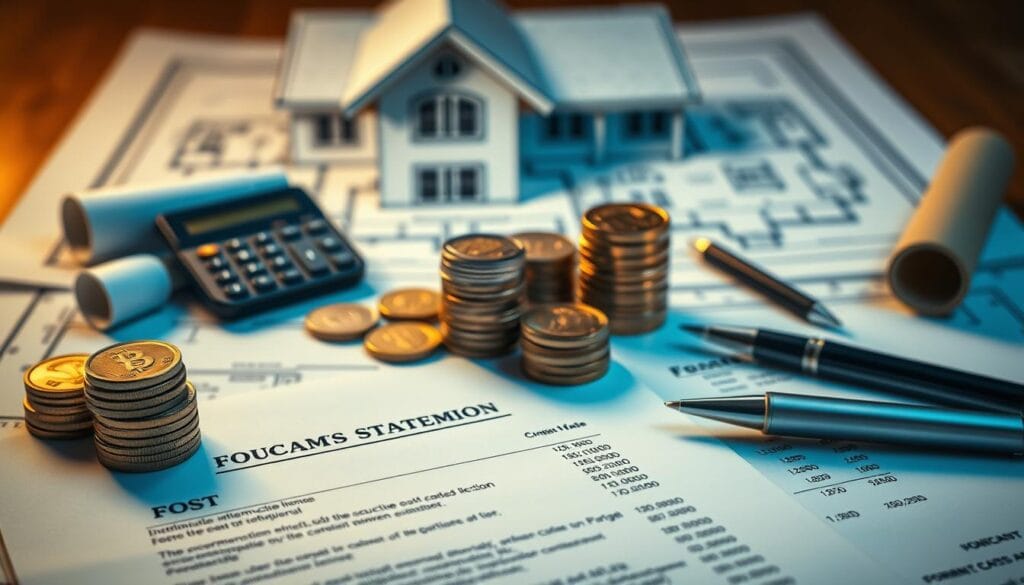
Understanding the financial aspects of your project is crucial for long-term success. From origination fees to closing costs, every expense plays a role in your overall budget. Proper planning ensures you avoid unexpected surprises and stay on track.
Origination Fees, Closing Costs, and More
Origination fees are a common expense, often ranging from 1% to 2% of the total amount. SCCU, for example, includes a $1,400 disbursement deposit structure, which covers inspections and disbursements. This upfront cost adds transparency to the process.
Closing costs can vary significantly depending on the lender and project type. Title search fees and appraisal costs are consistently expected in both construction and conventional loans. For a detailed breakdown, explore this guide on closing costs.
How to Minimize Additional Expenses
Negotiating builder retainage percentages can help reduce costs. Escrow accounts are also essential for managing tax and insurance payments. These strategies ensure you stay within budget while maintaining financial flexibility.
Bundling services with providers can lead to significant savings. For instance, USU offers low to no down payment options for ADUs, making it easier to manage upfront expenses. Tracking your expenses with tools like AI-powered apps can further enhance your financial planning.
Insurance premiums are another factor to consider. The type of project can impact these costs, so it’s important to evaluate your options carefully. Proper coverage ensures you’re protected throughout the process.
Tips for Building Your Dream Home on a Budget
Building your dream home doesn’t have to break the bank if you plan strategically. With careful budgeting and smart decision-making, you can achieve your vision without overspending. Whether you’re working with a small plot of land or a larger project, these tips will help you stay on track.
Planning and Prioritizing Your Needs
Start by outlining your priorities. What features are essential for your dream home? Value engineering strategies, such as using insulated concrete forms (ICF) instead of traditional framing, can reduce costs without compromising quality. USU’s phased construction options for ADU-first builds are a great example of how to manage expenses effectively.
Contingency budgeting is another critical step. Experts recommend setting aside 5-10% of your total budget for unexpected expenses. This ensures you’re prepared for surprises without derailing your project.
How to Avoid Costly Mistakes During Construction
Timeline management is key to avoiding unnecessary costs. Delays can lead to rate lock expiration or increased material prices. Regular inspections and milestone-based disbursements help keep the project on track. For more insights, check out this guide on building your dream home.
Energy efficiency is another area where smart investments can pay off. Premium installations like solar panels or energy-efficient windows may have higher upfront costs, but they offer long-term savings. Barndominium financing requirements often include energy efficiency considerations, making them a viable option for budget-conscious builders.
Frequently Overlooked Aspects of Construction Loans
Many borrowers focus on rates and terms but overlook critical details in their financing agreements. Insurance requirements and delay contingencies are essential yet frequently ignored aspects. Understanding these elements can save you from unexpected costs and complications.
Insurance Requirements During Construction
Insurance is a critical yet often overlooked aspect of financing. Builder’s risk coverage is typically required to protect against damage during the build. Policies often have specific thresholds and exclusions, so it’s important to review them carefully.
Lenders like SCCU and USU may also require additional coverage, such as liability insurance. These policies ensure that both the borrower and the lender are protected throughout the project. Understanding these requirements upfront can prevent delays and additional costs.
What Happens if Construction is Delayed?
Delays can lead to significant financial reassessments. SCCU’s rate reset protocol allows borrowers to adjust their terms if the project exceeds the 12-month timeline. This flexibility ensures that unexpected setbacks don’t result in unfavorable terms.
USU offers extension options with potential rate adjustments, providing additional security. Force majeure clauses in agreements also protect borrowers from delays caused by unforeseen events like natural disasters. Proper planning and communication with your lender can minimize the impact of delays.
The time period for completion is a key factor in planning. Regular inspections and milestone-based disbursements help keep the project on track. Post-delay financial reassessment requirements ensure that both parties are aligned on the revised timeline and costs.
Conclusion: Start Building Your Dream Home Today
Now is the perfect time to take the first step toward creating your dream home. With favorable conditions in 2025, securing a construction loan offers unique advantages compared to historical averages. Start by comparing lenders using key criteria like flexibility, transparency, and customer support.
For personalized insights, request a rate quote from trusted institutions like USU or SCCU. Strategic timing is crucial—begin your project before potential shifts in the market. This ensures you lock in the best terms for your build.
Next, focus on selecting the right builder and planning your project meticulously. For additional guidance on managing your finances, explore our tax filing software reviews. Take action today and turn your vision into reality.

